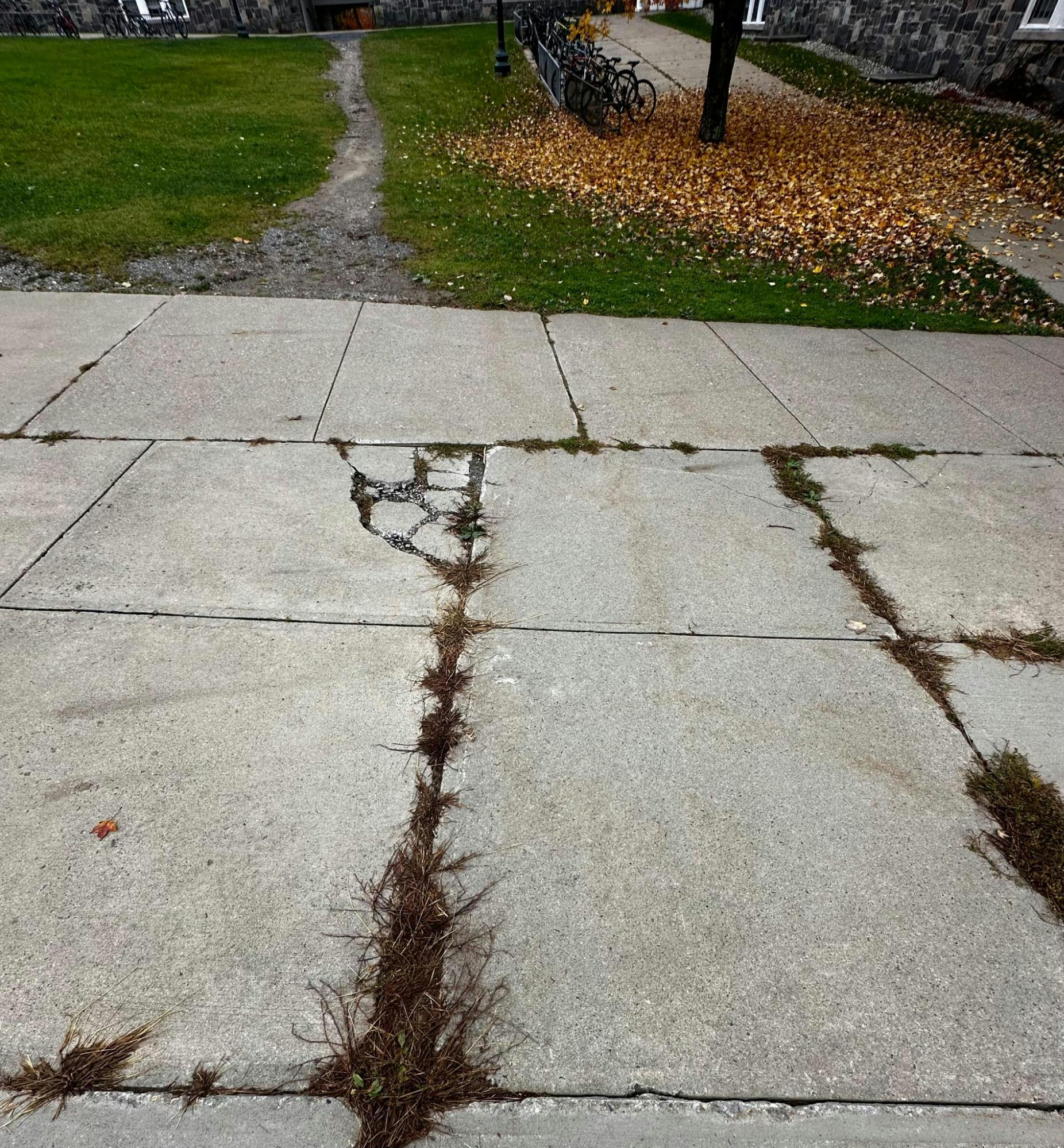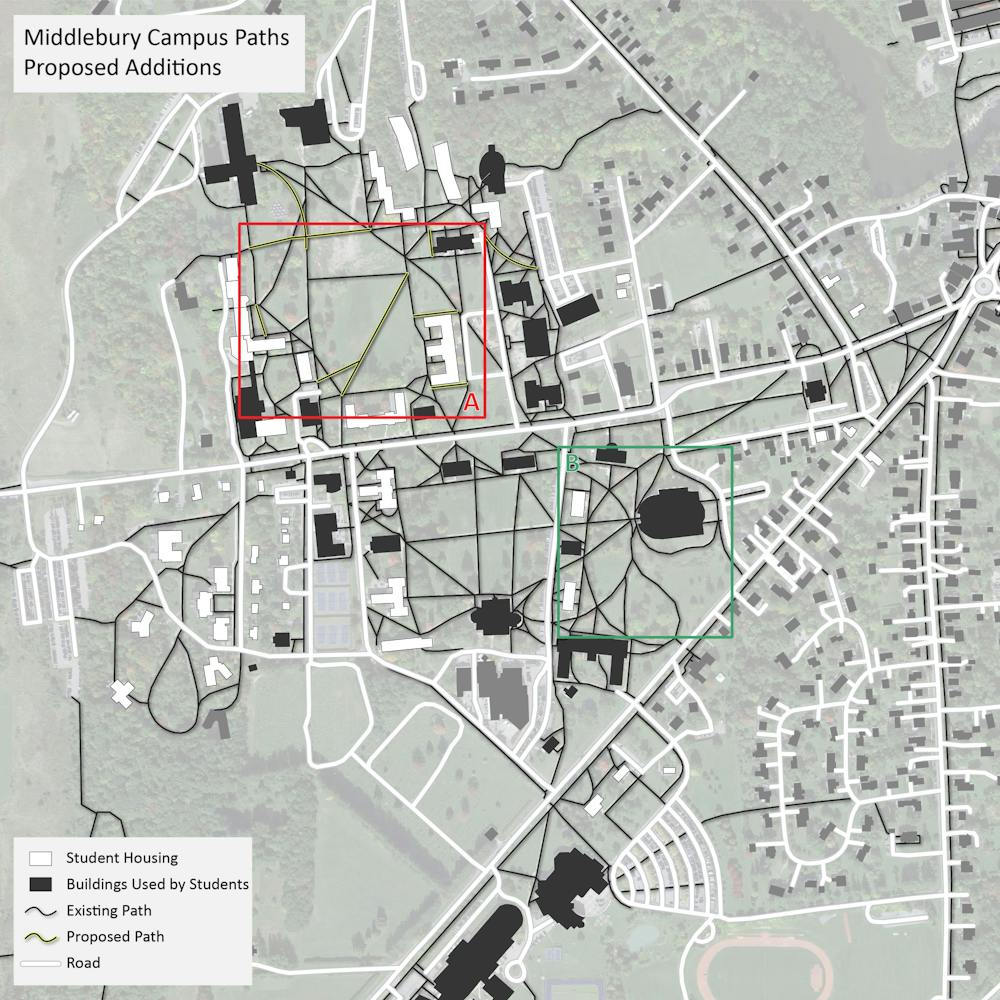Middlebury has a campus problem. While the majority of people might not notice some of the flaws with our campus, I believe that the physical layout of our sidewalks presents a logistical nightmare for lawn maintenance. By no means am I saying that the grounds crew that works day-in and day-out to pick up trash, mow the grass and clear the sidewalks is doing a bad job. They are what keeps this campus alive and beautiful. However, as I walk around campus, I notice some issues that are unique to Middlebury.
Missing Paths
The first issue is that there are some key connections missing between destinations. The photo above shows an example of a desire path — a route which has been naturally worked into the grass, but is not paved. Some notable examples are the connection from BiHall to Ross Dining Hall (in front of Hadley Hall), the diagonal route from Ross Dining Hall to Atwater Dining Hall and the route from Lang Hall to Atwater. But desire paths are inaccessible and impermanent solutions. For one, they cannot be cleared of snow during the wintertime, meaning they can become icy and unsafe. These paths are also not hard surfaces, meaning anyone who is injured or disabled would be forced to follow the existing but indirect network of sidewalks. They also create a low-point on the surface that water can erode, which is what we are seeing between Hadley and Milliken Hall.
What do all of these examples have in common? People want to take the quickest route from point A to point B, and no such route exists in these spaces, or the detour is significantly longer. I propose a simple solution to this problem, which is adding new paths to fill in these needed routes. I have drawn a map to illustrate these changes.
Intersections and Cutting Corners
The second issue is that Middlebury’s path network lacks any natural form. Region A on the map above shows an example of straight paths connected through a series of intersections, as opposed to Region B, where the newer paths near Davis Family Library naturally flow with the direction of travel. This more natural form allows for fewer intersections and less congestion. While we don’t exactly have a traffic issue, I’m sure some students have been in that awkward stand-off when trying to make a turn and you bump into someone coming the other direction.
Have you ever noticed the abundance of dead grass around path intersections? I suspect that this issue is caused by people cutting the corner to save a few seconds, which isn’t necessarily bad, and I don’t blame you. I think one solution would be to redesign the paths to be slightly wider and have fewer corners. I propose a more natural shape to the campus paths, which will lead to fewer intersections and reduce the need to cut corners.

Sidewalk Material
When it does come time for the sidewalks to be renovated, a major consideration will be what material to use to pave the sidewalks. One option is concrete, the light gray stuff we have on campus, and a second option is asphalt, the black material commonly used for roads. In theory, concrete is supposed to last longer than asphalt and be more ADA friendly. Some sources say concrete can last up to 50 years, while others say it only lasts up to 30 years. Asphalt is supposed to be slightly cheaper and less durable than concrete. While both have their advantages and disadvantages, they will both inevitably deteriorate over time and require replacement.
Before considering which material might be better, we should first look at what other colleges in the area are using for sidewalk material. Based on my research, some schools like Williams College, University of Vermont and Dartmouth College use mostly concrete paths, while others, like Colby College, Bowdoin College, Bates College and Amherst College use mostly asphalt. While most wouldn’t notice the differences in the materials, a keen observer can pick up on some subtle changes. For bicyclists, the concrete paths have a sharp curb, meaning if you ride off the sidewalk, it is much more difficult to get back on. Skateboarders and people on scooters instantly feel how difficult it is to ride on a concrete sidewalk. The small wheels don’t handle unevenness and slow down over each crack in the concrete. Additionally, concrete has joints that allow the surfaces to move over time, which are prone to moving during the freeze-thaw cycles of Vermont winters.
As seen in the photo above, many of our concrete paths are falling apart and are in need of replacement. I propose a new network with a hybrid of concrete and asphalt paths. As long as the concrete is poured to a high standard, it shouldn’t need maintenance for many years. With the asphalt, skateboarders can get around easier, there will be less cracks to trip on and its continuous surface will be easier to plow without catching a snow plow blade. These asphalt paths would be slightly wider and comprise the most highly trafficked routes, especially those used by facilities when driving. If you are doubting how the asphalt paths might look, I encourage you to check out a photo of Amherst’s campus, and if you want an example of concrete paths, check out Boston College’s campus.
Overall, Middlebury’s campus is beautiful and well-maintained, but a few design flaws and lack of sidewalk maintenance has led to an unpleasant experience when walking to and from class or meals. With some slight changes and new materials, I believe we can turn the current maze of intersections into a cohesive system of walkways.


